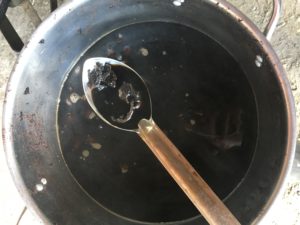
A few months ago, our generous neighbor gave me some butternut hulls for dyeing. Butternut are a hardwood tree that were at one time very common across New England. Unfortunately, over-harvesting for the furniture industry has led to their scarcity.
It may not be possible to locate a sustainable source of butternut hulls where you live. But since I had access to them, I decided to try them out. Walnut hulls are readily available and the method for dyeing with them is exactly the same.
To dye with Butternut
For this experiment I started with about 4 cups of butternut hulls and dyed 200 grams of yarn. This was a ratio of about 2:1 dyestuff to weight of wool.
Step 1: Mordant the yarn (optional)
You can choose whether to mordant the yarn in this case, or not. Since nut trees have naturally-occurring tannins in the hulls of their fruit, mordanting may not be necessary, but might give a more saturated color or different tones, depending on the mordant used.
If mordanting with alum, I use a 10% by weight-of-goods proportion of alum to wool. Botanical Colors has a great tutorial on mordanting with alum.
Step 2: Extract the dye and wet the yarn.
Place a large non-reactive pot on your heat source and simmer the butternut hulls in warm water (180 – 190 F). Stir occasionally and cook for 45 minutes.
While the color is extracting, wet your yarn out in hot water in a covered container (like a bucket or extra pot with a lid) to retain the heat.
When the color of the dye is looking saturated (nearly black), strain off the liquid into another pot or bucket. I use a mesh paint strainer for this purpose to catch all the fine plant material.
Step 3: Dye the fiber.
Pour the dye liquid into your dye kettle and place back on the heat source.
Gently lift your yarn or fiber out of the soaking container and place into the dye kettle. Give it a gentle stir and poke to submerge.
Simmer the yarn in the dye bath for at least an hour, giving it a gentle swish every once in a while (too much agitation can felt the wool, so stirring should be infrequent).
After about an hour, turn off the heat and cover the pot. I like to leave my dye kettles overnight to cool slowly.
Step 4: Rinse and dry.
Gently lift the fiber out of the dye kettle and allow the excess dye liquor to drain back into the pot. Then transfer to a bucket of clean water and let soak for a couple of minutes. If necessary, lift the fiber out of the rinse bucket and place into a third bucket or pot of clean water, to rinse a second time.
In a shady spot, hang the wet yarn up to dry or drape over the back of a lawn chair and allow to dry. You might want to bring the yarn inside after it stops dripping, as humidity in the air can keep it from drying completely outside.
Have you tried dying with butternut or walnut hulls? We’d love to know. Leave a comment here or on the accompanying video and let us know how it turned out.
